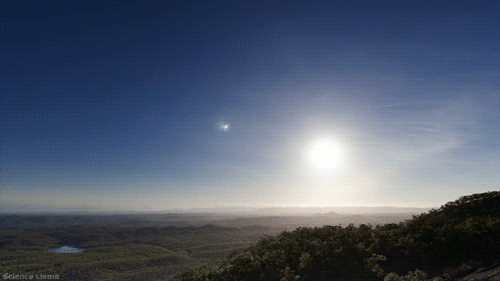
13 Must See Stargazing Events for 2013
— Listed In Chronological Order1) January 21 — Very Close Moon/Jupiter Conjunction
A waxing gibbous moon (78% illuminated) will pass within less than a degree to the south of Jupiter high in the evening sky. Your closed fist held out at arms length covers 10 degrees. These two wont get that close again until 2026.
2) February 2-23 — Best Evening View of Mercury
The planet Mercury will be far enough away from the glare of the Sun to be visible in the Western sky after sunset. It will be at its brightest on the 16th and dim quickly afterwards. On the 8th it will skim by the much dimmer planet Mars by about 0.4 degrees.
3) March 10-24 — Comet PANSTARRS at its best
First discovered in 2011, this comet should be coming back around for about 2 weeks. It will be visible low in the northwest sky after sunset. Here are some sources predicting what the comets may look like in the sky; 1, 2
4) April 25 — Partial Lunar Eclipse
A very minor, partial lunar eclipse (not visible in North America) where only about 2 percent of the moon’s diameter will be inside the dark shadow of the Earth.
5) May 9 — Annular Eclipse of the Sun (“Ring of Fire” Eclipse)
It will be visible in Northern Australia and parts of Papua New Guinea but mostly within the Pacific Ocean. See all the solar eclipse paths for 2001-2020 here.
6) May 24-30 — Dance of the Planets
Mercury, Venus and Jupiter will seemingly dance between each other in the twilight sky just after sunset as they will change their positions from one evening to the next. Venus will be the brightest of all, six times brighter than Jupiter.
7) June 23 — Biggest Full Moon of 2013
It will be the biggest full moon because the moon will be the closest to the Earth at this time making it a ‘supermoon’ and the tides will be affected as well creating exceptionally high and low tides for the next few days.
8) August 12 — Perseid Meteor Shower
One of the best and most reliable meteor showers of the year producing upwards of 90 meteors per hour provided the sky is dark. This year the moon won’t be in the way as much as it will set during the evening leaving the rest of the night dark. Here is a useful dark-sky finder tool.
9) October 18 — Penumbral Eclipse of the Moon
Visible mostly in Asia, Europe and Africa, at this time the 76% of the moon will be covered by the penumbral shadow of the Earth.
10) November 3 — Hybrid Eclipse of the Sun
A Hybrid Eclipse meaning, along its path, the eclipse will turn from Annular to Total and in this case most of the path will appear to be Total as there will be a slight ring of sunlight visible near the beginning of the track. This one will begin in the Atlantic (near the East Coast of the U.S.) and travel through Africa. See the path here. The greatest eclipse (with 100 seconds of totality) will appear in Liberia, near the West Coast of Africa.
11) Mid-November through December — Comet ISON
The second comet this year, ISON, could potentially be visible in broad daylight as it reaches its closest point to the Sun. It will reach that point on November 28 and it is close enough to the Sun to be categorized as a ‘Sungrazer’. Afterwards it will travel towards Earth (passing by within 40 million miles) a month later.
12) All of December — Dazzling Venus
The brightest planet of them all will shine a few hours after sundown in the Southwestern sky and for about 1.5 hours approaching New Years Eve. Around December 5th, a crescent moon will pass above the planet and the next night Venus will be at its brightest and wont be again until 2021.
13) December 13-14 — Geminid Meteor Shower
This is another great (if not the best) annual meteor shower. This year put on a show at about 120 meteors per hour and in 2013 it won’t be much different so expect another fantastic show. However, the moon - as it is a few days before full phase - will be in the way for most of the night obscuring some of the fainter meteors. You might have to stay up in the early morning hours (4am) to catch the all the meteors it has to offer. If you missed 2012’s Geminid Meteor Shower, here are some great photo-sets; 1, 2, 3